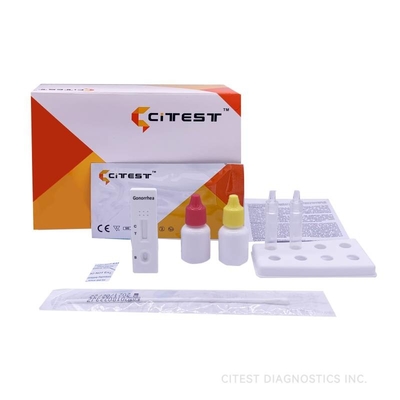

Gonorrhea Rapid Test, detection of Neisseria gonorrhoeae, female cervical swab and male urethral swab
Applications:
The Gonorrhea Rapid Test Cassette (Swab) is a rapid chromatographic immunoassay for the qualitative detection of Neisseria gonorrhoeae in female cervical swab and male urethral swab specimens to aid in the diagnosis of Gonorrhea infection.
| Principle | Chromatographic Immunoassay |
| Format | Cassette |
| Specimen | Swab |
| Certificate | CE |
| Reading Time | 10 minutes |
| Pack | 20 T |
| Storage Temperature | 2-30°C |
| Shelf Life | 2 Years |
| Sensitivity | 94.40% |
| Specificity | 96.90% |
| Accuracy | 95.90% |
Description:
Gonorrhea is a sexually transmitted disease caused by the bacterium Neisseria gonorrhoeae. Gonorrhea is one of the most common infectious bacterial diseases and is most frequently transmitted during sex/ual intercourse, including vaginal, oral and anal sex. The causative organism can infect the throat, producing a severe sore throat. It can infect the anus and rectum, producing a condition called proctitis.
With females, it can infect the va/gina, causing irritation with drainage (vaginitis). Infection of the urethra may cause urethritis with burning, painful urination, and a discharge. When women have symptoms, they often note vaginal discharge, increased urinary frequency, and urinary discomfort. Spread of the organism to the fallopian tubes and abdomen may cause severe lower-abdominal pain and fever. The average incubation for Gonorrhea is approximately 2 to 5 days following sex/ual contact with an infected partner. However, symptoms may appear as late as 2 weeks. A preliminary diagnosis of Gonorrhea can be made at the time of examination1 In women, Gonorrhea is a common cause of pelvic inflammatory disease (PID).
PID can lead to internal abscesses and long-lasting, chronic pelvic pain. PID can damage the fallopian tubes enough to cause infertility or increase the risk of ectopic pregnancy.2A smear or swab of urethral or cervical discharge may be taken and tested using a Gonorrhea Rapid Test Cassette (Swab)
How to use?
Allow the test, reagents, swab specimen, and/or controls to reach room temperature (15-30℃) prior to testing.
1.Remove the test cassette from the seal pouch and use it as soon as possible. Best result will be obtained if the test is performed immediately after opening the foil pouch.
2.Extract the Gonorrhea antigen according to the specimen type.
· Hold the reagent 1 bottle vertically and add 5 drops of reagent 1 (approx. 300ul) to the extraction tube. Reagent 1 is colorless. Immediately insert the swab, compress the bottom of tube and rotate swab 15 times. Let stand for 2 minutes.
· Hold the reagent 2 bottle vertically add 4 drops of reagent 2 (approx. 200ul) to the extraction tube. The solution would turn turbid. Compress the bottle of tube and rotate the swab 15 times until the solution turn clear with a slight green or blue tint. If the swab is bloody, the color will turn yellow or brown. Let stand 1 minute.
· Press the swab against the side of tube and withdraw the swab while squeezing the tube. Keep as much liquid in the tube as possible. Fit the dropper tip on top of extraction tube.
3.Place the test cassette on a clean and level surface. Add 3 full drops of the extracted solution (approx. 100ul) to the specimen well of the test cassette, then start the timer. Avoid trapping air bubbles in the specimen well.
4.Wait for the color to appear. Read the result at 10 minutes; do not interpret the result after 30 minutes.
![]()
INTERPRETATION OF RESULTS
(Please refer to the illustration above)
POSITIVE:* Two lines appear. One colored line should be in the control line region (C) and another apparent colored line should be in the test line region (T). A positive result indicates that Gonorrhea was detected in the specimen.
*NOTE: The intensity of the color in the test line region (T) will vary depending on the concentration of Gonorrhea present in the specimen. Therefore, any shade of color in the test line region (T) should be considered positive.
NEGATIVE: One colored line appears in the control line region (C). No line appears in the test line region (T). A negative result indicates that Gonorrhea antigen is not present in the specimen, or is present below the detectable level of the test.
INVALID: Control line fails to appear. Insufficient specimen volume or incorrect procedural techniques are the most likely reasons for control line failure. Review the procedure and repeat the test with a new test. If the problem persists, discontinue using the test kit immediately and contact your local distributor.